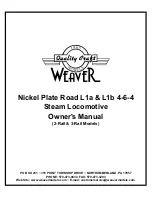
21
2. Binnacle
Build the binnacle from walnut stripwood.
Chamfer the edges (just sand) of the fake
drawer fronts so the seams show up better.
The drawer pulls can be made from the
small nails included in the kit or a straight
pin head (
Figure 5-3
).
On the real ship, the binnacle is assumed
to be bolted to the deck and not lashed
down to deck as you would find on other,
larger ships. Just glue it to the deck. The
inside of the binnacle can be painted black
so you cannot see anything inside. As an
option for more detail, add a small com-
pass in the box and use a clear plastic
sheet over the opening to represent glass.
On a real ship, the binnacle would have a
lantern in the box on each side to illumi-
nate the compass. The three small holes
on the ends of the binnacle are vent holes
for the lanterns.
3. Boom Crutches
The laser-cut walnut boom crutches fit on
the outboard edges of the transom on top
of the cabin top rail. Shape the bottom of
the crutch as necessary for the correct
angle. Round the top edges a bit. Add a
cleat on the face of each for belaying the
after spreader yard braces (
Figure 5-4
).
4. Cabin Doors
The doors were installed along with the
planking for the front of the cabin. Refer
to Stage 2. Fake hinges can be made from
a short piece of 0.020" dia. brass wire
glued at the seam. The handles are also
made from wire (
Figure 5-5
).
5. Cannon
The cannon barrels are britannia castings. The
carriage cheeks and the trucks are laser-cut
walnut parts. Make the axles, transom, bed
block, and quoin from walnut stripwood. The
quoin handle could be a brass or wood belay-
ing pin or carved from wood. The trunnion
straps or bands (correct name is cap square)
can be made from 1/64" x 1/16" brass strip
supplied in the kit, or from a thinner brass
sheet (not supplied) or paper strip. For the
ringbolts on the cheeks, use the 3/32" split
ring supplied in the kit. For the ringbolts on
the bulwarks, use 1/8" split rings and the
1/16" o.d. eyebolts. Assemble the cannons as
shown in
Figure 5-6
, and rig per
Figure 5-7
.
There is a ringbolt in the deck behind each
gun that would be used to hook an inhaul
or train tackle. The tackle is not rigged on
our model, as it was most likely portable
or not used at all. Use 1/8" split rings and
1/16" o.d. eyebolts for these.
The cannons are located at the first 3 gun-
ports port and starboard. Although there
are fittings on the after gunport, this was
probably an emergency position. To rig a
gun there, the pump handles would have
to be removed.
FIG. 5-5 CABIN DOORS
PIECE OF WIRE
FOR FAKE
HINGE
WIRE HANDLE
CHAMFER EDGES TO
EMPHASIZE SEAMS
FIG. 5-6 ASSEMBLING THE CANNONS
TRUNNION STRAP
BRASS STRIP
CANNON
BRITTANIA
CASTING
TRANSOM
AXLE
TRUNNION STRAP
LASER CUT
CHEEK
RINGBOLT
LARGE
LASER CUT
TRUCK
SMALL LASER
CUT TRUCK
EYEBOLT
BLOCK
SUPPORT
ROD
AXLE
BED
BLOCK
QUOIN
FIG. 5-7 RIGGING THE CANNON
GUN TACKLE
BLOCKS WITH
HOOKS
EYEBOLT
RINGBOLT
SEIZE
BREECH
LINE
FIG. 5-8 CHANNELS
TAPER
DOWEL &
GLUE
CHANNEL
SLOTS FOR
CHAIN PLATES
COVER STRIP
















































